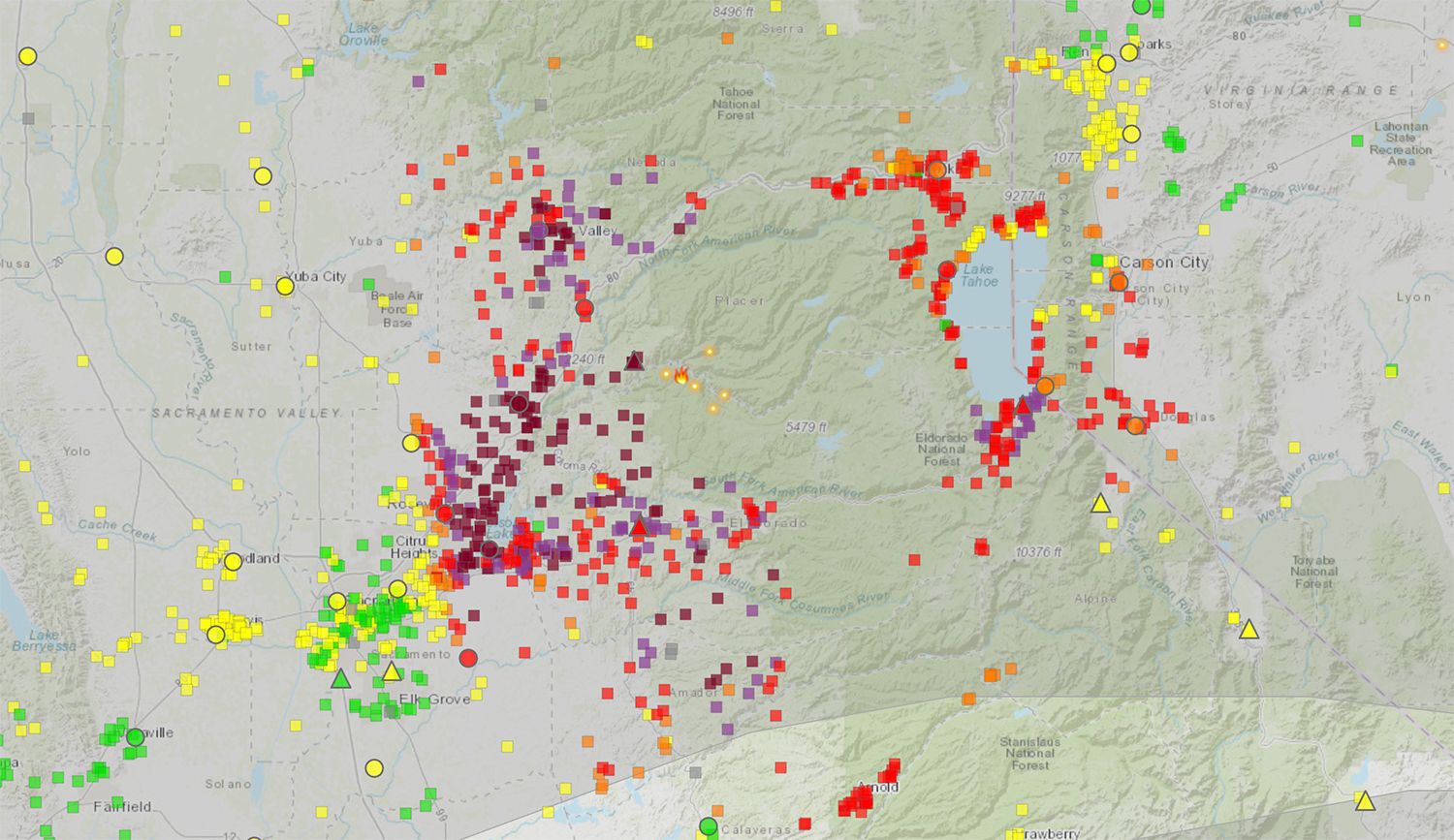A wildfire that broke out Tuesday in Placer County, west of Lake Tahoe, grew significantly on Thursday and overnight, aided by ongoing hot and dry conditions. And it has begun ruining the air quality for late-summer pleasure-seekers around the Lake Tahoe basin.
The Mosquito Fire had grown to 14,250 acres as of Friday morning, after jumping the American River into El Dorado County. As of Wednesday, the fire had been under 1,000 acres, so its growth over 48 hours has been exponential.
The fire is burning in a remote but not unpopulated area, and evacuation orders are in place for multiple locales in Placer County, as well as part of Volcanoville in El Dorado County — an unincorporated area with an estimated population of around 230. Per Cal Fire, the Mosquito Fire "showed extreme fire behavior and growth" in its three first days, and, "The fire is burning in extremely difficult terrain including steep canyons where directly attacking the fire can be difficult."
The fire is said to be threatening around 1,000 homes.
The speed of the fire's growth and the tinder box of fuel in the woods that are in its path could mean this could the second year in a row that a wildfire threatens the Tahoe Basin — following 2021's Caldor Fire which blanketed the lake with smoke last Labor Day and caused the first fire evacuation of South Lake Tahoe in 14 years.

The cause of the fire remains under investigation, but wouldn't you know, PG&E admitted on Thursday that it recorded an electrical fault in the area near the fire's ignition point at Oxbow Reservoir on Tuesday right when the fire began. As CBS News reports, "While the fault happened around the same time as the start the Mosquito Fire... PG&E notes that they haven't seen any damage or abnormal conditions at the power pole." The fire-prone utility company further wrote in its transparency memo to the California Public Utilities Commission, "Thus far, PG&E has observed no damage or abnormal conditions to the pole or our facilities near Oxbow Reservoir has not observed down conductor in the area or any vegetation related issues."
But yeah, just a coincidence maybe, that electrical fault right around that time.
A similar thing happened a few days after last year's Dixie Fire, which ultimately grew to the second-largest fire in state history at 963,000 acres. PG&E wrote a letter to the CPUC saying, "Yeah, so, we had a technician out near where that fire began who was looking into a blown fuse and he saw some flames at the bottom of a power pole." PG&E's equipment was ultimately found responsible for sparking that fire, and a subsequent state report released in June found that PG&E was negligent in its tree-removal program in the area, and its response the day the fire started was "excessively delayed."
Smoke is impacting air quality in northeastern Sacramento, Placerville, and all around Lake Tahoe, as the Chronicle reported Friday and as shown in the AirNow map below.
The National Weather Service warned the Bay Area on Friday that drifting smoke from this and the Fairview Fire in Riverside County is likely to begin affecting our air quality this weekend as well, so be sure to consult AQI maps before deciding weekend plans.

Smoke from fires across the state pushes into the Bay Area today and tomorrow, but most of the smoke is expected to be elevated. Pay attention to air quality alerts from local air quality districts and get the latest information at https://t.co/WQ0XLAmi67. pic.twitter.com/QJqg08kuoE
— NWS Bay Area 🌉 (@NWSBayArea) September 9, 2022
Gov. Gavin Newsom on Thursday declared a state of emergency in El Dorado and Placer counties, and this also applied to Riverside County for the Fairview Fire, which is now at 27,000 acres.
As the New York Times reports, Riverside County is under multiple extreme weather alerts Friday as winds and rains arrive from Tropical Storm Kay, and threaten the area with possible lightning, flooding, and mudslides.
Chronicle meteorologist Gerry Diaz says that former Hurricane Kay will bring some "strange weather" our way this weekend, and may either help or hinder the firefight in Placer and El Dorado counties, depending on what happens. If the hurricane remnants bring actual rain to the area, that will obviously help slow the growth of the Mosquito Fire, but dry lightning and wind remain possibilities as well, which will only make the fire worse.
Top image via AlertWildfire

